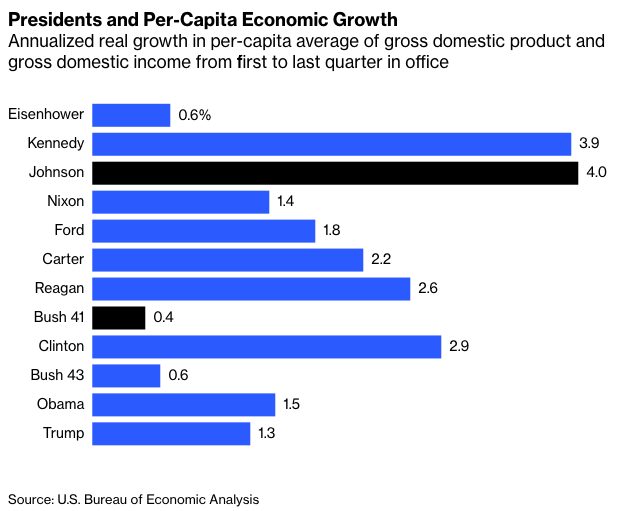This puts Trump ahead of both George Bushes, although still trailing everyone else.
Economic growth is generally lower than it was a few decades ago, and this is probably not the fault of a particular president. One likely cause is the slowdown in population growth. Correct for that using the BEA’s quarterly estimates of U.S. population, and it brings a few more changes.

The rapid population growth during Eisenhower’s time in office (1.8% per year, highest among the presidents on the chart) consisted almost entirely of babies, who tend not to be big economic contributors from the get-go, so I would advise cutting Ike some slack here. In the past I have tried using the Bureau of Labor Statistics’ monthly estimates of 16-and-older civilian population to get around this, but for reasons involving the end of the Korean War and the fact that the BLS estimates exclude uniformed military personnel, that doesn’t entirely bail him out either. For Trump, factoring in population growth puts him well ahead of three presidents (Eisenhower and the Bushes) and not far behind Nixon and Obama, although still nowhere close to top performers such as Lyndon Johnson, John Kennedy, Bill Clinton, Ronald Reagan and, ahem, Jimmy Carter.
All of those top performers except Reagan were Democrats, which has not gone unnoticed by economists. Over the nearly 75 years for which we have reliable quarterly GDP and monthly jobs numbers, the growth of both has been markedly faster during Democratic presidencies than Republican ones. In 2016 the very eminent Alan S. Blinder and Mark W. Watson of Princeton undertook “An Econometric Exploration” of this phenomenon for the American Economic Review and came to the not especially helpful conclusion that:
the Democratic edge stems mainly from more benign oil shocks, superior total factor productivity (TFP) performance, a more favorable international environment, and perhaps more optimistic consumer expectations about the near-term future.
That sounds mainly as if the Democrats have just been luckier, and perhaps better at inculcating optimism. In an updated analysis earlier this year, David Leonhardt of the New York Times suggested that it might also have something to do with Democrats being more pragmatic than Republicans, who since 1980 have focused on tax cuts as the main instrument of national economic policy, or with Democratic economic pressure groups such as labor unions favoring policies “that lift broad-based economic growth” while Republican economic pressure groups focus, again, on tax cuts.
Trump offered hints of a different economic approach, but the signature legislative accomplishment of his term was another big tax cut and his growth numbers will drag the Republican averages down even further. Maybe it’s mostly bad luck. This is getting to be an awfully long run of it, though.
Justin Fox is a Bloomberg Opinion columnist covering business. He was the editorial director of Harvard Business Review and wrote for Time, Fortune and American Banker. He is the author of The Myth of the Rational Market.








